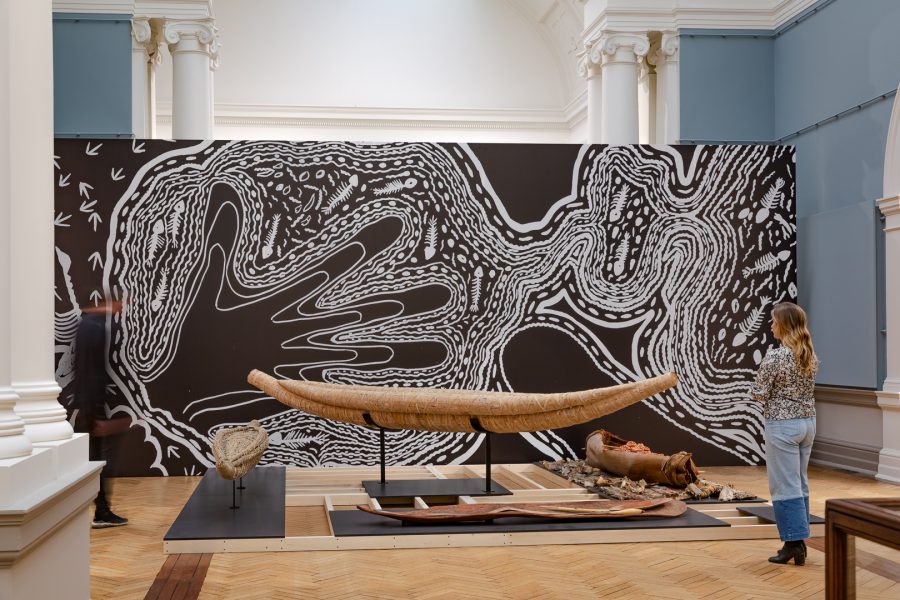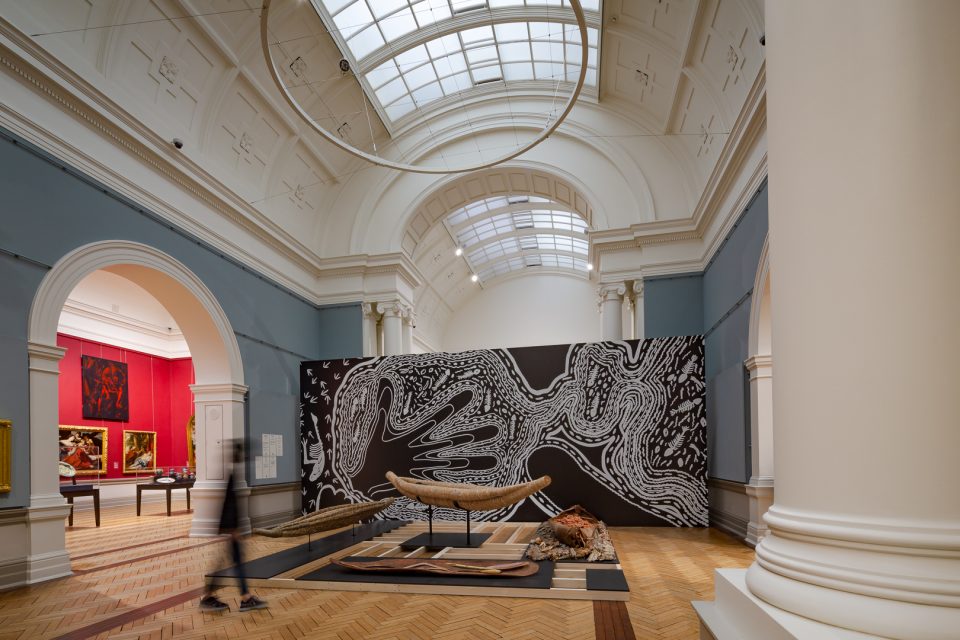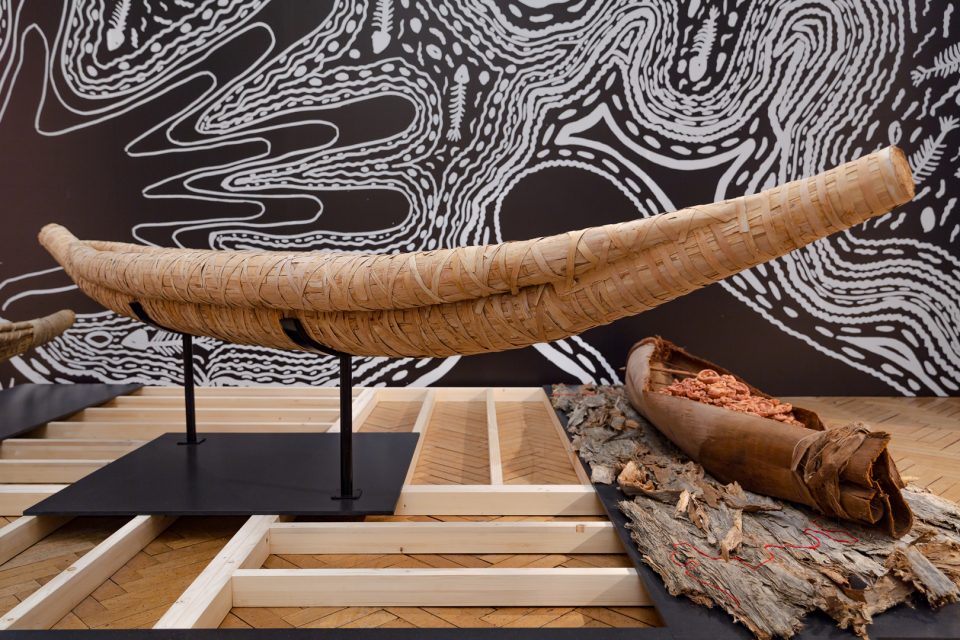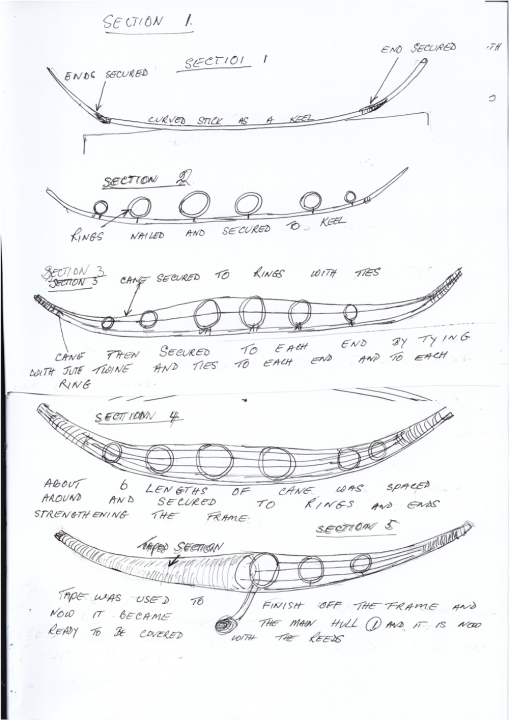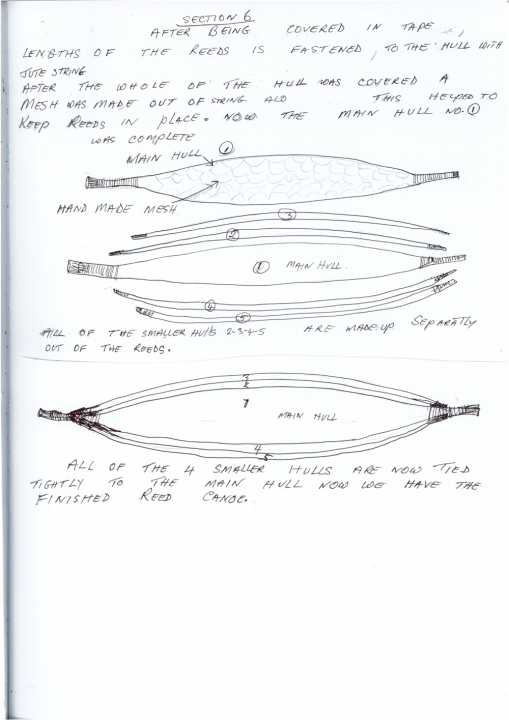Ningher (reed canoe) 2020
reeds (Phragmites australis) and hand-rolled string made from seagrass cord and jute twine
Purchased 2021 with funds from Gina Fairfax through the Queensland Art Gallery | Gallery of Modern Art Foundation Collection, Queensland Art Gallery | Gallery of Modern Art
Tasmanian Aboriginal paperbark canoe 2012
paperbark, wood, twine
On loan from the National Museum of Australia, Canberra
Presentation at the 23rd Biennale of Sydney (2022) was made possible with generous assistance from Arts Tasmania by the Minister for the Arts
The Greeno family are master Palawa cultural practitioners. Senior Craftsman Rex and his son Dean Greeno work together as well as having individual practices. Growing up at Lady Barron, the southern end of Flinders Island in the Bass Strait, Rex learned from his grandfather Silas Mansell how to set kangaroo snares, fish, hunt, and catch and process mutton birds.
Two styles of Tasmanian canoes are presented for the 23rd Biennale of Sydney. Through research, Rex discovered that canoes made from reeds or rushes had three to five hulls and were mainly used on the lagoons, small lakes and marsh areas along the eastern coast of Tasmania from Bicheno to Maria Island. Rex and Dean built the first swamp tea-tree bark canoe in Tasmania in 200 years (Tasmanian Aboriginal paperbark canoe 2012). In the natural environment, the bark and native fibres change over time, and you can notice some fading in the paperbark canoe from sunlight.
Rex Greeno says,
‘The paperbark I had previously used was really fairly flexible and [it was] easy to manipulate the fibres. The reeds are very brittle once dried out [so] this has forced me to change my technique, to suit the reeds, and enabled me to construct the canoe as shown in my drawings.’
Rex’s Reed Canoe Construction information Nov 2021
When the early explorers arrived in Tasmania, they noted that there was 3 types of material used to construct canoes for example:
- Stringy Bark
- Swamp tea tree-paper bark
- Reeds
There is virtually no information recorded on the reed canoes. I discovered the canoes made from reeds or rushes had 3 to 5 hulls and were mainly used on the lagoons, small lakes and marsh areas along the eastern coast from Bicheno to Maria Island.
There is drawing of a canoe that measured 30 cm long.
I have already built canoes from swamp tea tree bark, the first one for 200 years. As I am an experienced seaman in commercial fishing for about 40 years, Part of my sea experience came from helping to build a fishing boat.
I had a reasonable amount of marine experience to construct a reed canoe.
I was unable to collect the same reeds/rushes due lack of access to properties and river lands. I was able to get a suitable reed from the edge of the Tamar River.
The paper bark I had previously used was really fairly flexible and easy to manipulate the fibres. The reeds are very brittle once dried out this has forced me to change my technique, to suit the reeds enable me to construct the canoe as shown in my drawings. After 3 months of designing and getting used to the brittle reeds. I finally went ahead to create the canoe.
This is my explanation of my drawing that are done in sections, to show you.
Section 1:
Firstly, I select a curved stick about 2 cm in thickness then a small curved stick was nailed and glued to each end this formed the keel, bow and stern of the canoe.
Section 2:
Rings made from cane and secured by nailing them and securing them with plastic ties to the keel. These rings were of different diameters to shape the hull of the canoe.
Section 3:
Lengths of cane was then secured to each ring then secured to the bow and the stern, so either end of the canoe.
Section 4:
About 6 lengths of cane was secured to the bow and stern with jute string heavily bound and secured with plastic ties.
Section 5:
After all the cane length were fastened along the frame. The whole of the frame was bound by using packing tape this tied all of frame together that is then ready to be covered by reeds.
Section 6:
As noted previously, the paper bark, I used to make bark canoes from was very pliable fibre that enabled me to twist it in any direction.
The reeds once dried out are very brittle so it needs extra care while attempting to bend the reeds to shape. After the reed canoe has been covered in tape. It was quite risky to collect the reeds as I gather them at low tide in lots of mud up to my knees.
Once I have covered the number 1 Hull in reeds. I then created a mesh with cut out of sisal string, to bind all the reeds together.
The other 4 smaller hulls were made out of longer length reeds that are bound tightly to the main hull to form the completed canoe. My Reed Canoe is the first 5 hull reed canoe made for approximately 200 years.
My reed canoes are constructed in a more contemporary style. I use materials that are available today. My ancestors constructed their canoes from the materials close at hand in their time.
